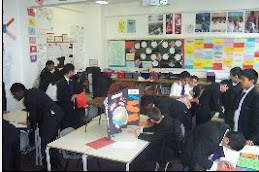
Last week a primary teacher told me her method for students entering 'story-telling' time in the hall. She would take students to the hall, leave them in the corridor with an assisting adult and then she would go into the empty room. Ten seconds later ONE child was allowed to enter and she would silently motion for them to pick up a mat and sit down on it at the edge of the room. At 10 second intervals the remaining students came into the room and, seeing what the child in front had done, would do the same. Silence remained throughout and by the end the room was serene and calm, perfect for story-telling.
While impressed by the image of children in such a receptive learning state, I thought about how difficult this would be to manage with my particular brood of teenagers. I thought about how my students might fight in the corridor, or make burping noises to throw off the silence, or trip over each other just to break the peacefulness. But even though this method might not be right for my students, I agree that the way students enter the class is VITAL for setting the readiness to learn.
So, what is my method for getting students into my classroom calmly and effectively?
1. Model expectations - on the first day I keep my classroom door closed until I am ready to let students in. I then greet students at the door and allow them to enter one-by-one, looking each one in the eye and saying hello. Once in, I shut the door and explain that students are always welcome into my classroom when the door is open. At all other times they must knock and wait because in our classroom we are often concentrating on difficult issues and we might need to finish thinking about those before the door can be opened.
2. Only let students in when the classroom is ready - The reason I have the door rule is because I like my room to be set-up when students come in. Sometimes students can help set-up and on those days the door is open because I am ready for their help. Other days it is closed, and this means they must wait patiently. By having my classroom ready I can focus on behaviour management and saying positive things to my students as they enter.
3. Use names as soon as you can - I make a point of learning names on the first lesson of the year and I use them relentlessly. Say hello to students, notice new things they might have or enquire about something they are interested in (i.e. "Asher I missed PrisonBreak the other night, what happened..."). All of these things let students know you have seen them and help build relationships.
4. Starter activities - Always have something for students to do or think about as soon as they enter the room as it engages attention, starts learning and reduces the likelihood of misbehaviour.
Tomorrow: What to do when the door closes but the students are late? Systems for lateness is on its way....
